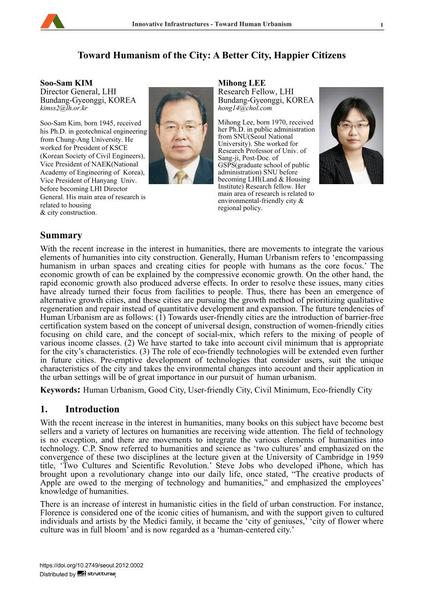Toward Humanism of the City: A Better City, Happier Citizens

|
|
|||||||||||
Bibliographic Details
| Author(s): |
Soo-Sam Kim
(Director General, LHI, Bundang-Gyeonggi, KOREA)
Mihong Lee (Research Fellow, LHI, Bundang-Gyeonggi, KOREA) |
||||
|---|---|---|---|---|---|
| Medium: | conference paper | ||||
| Language(s): | English | ||||
| Conference: | 18th IABSE Congress: Innovative Infrastructures – Towards Human Urbanism, Seoul, Korea, 19-21 September 2012 | ||||
| Published in: | IABSE Congress Seoul 2012 | ||||
|
|||||
| Page(s): | 2-5 | ||||
| Total no. of pages: | 4 | ||||
| DOI: | 10.2749/seoul.2012.0002 | ||||
| Abstract: |
With the recent increase in the interest in humanities, there are movements to integrate the various elements of humanities into city construction. Generally, Human Urbanism refers to ‘encompassing humanism in urban spaces and creating cities for people with humans as the core focus.’ The economic growth of can be explained by the compressive economic growth. On the other hand, the rapid economic growth also produced adverse effects. In order to resolve these issues, many cities have already turned their focus from facilities to people. Thus, there has been an emergence of alternative growth cities, and these cities are pursuing the growth method of prioritizing qualitative regeneration and repair instead of quantitative development and expansion. The future tendencies of Human Urbanism are as follows: (1) Towards user-friendly cities are the introduction of barrier-free certification system based on the concept of universal design, construction of women-friendly cities focusing on child care, and the concept of social-mix, which refers to the mixing of people of various income classes. (2) We have started to take into account civil minimum that is appropriate for the city’s characteristics. (3) The role of eco-friendly technologies will be extended even further in future cities. Pre-emptive development of technologies that consider users, suit the unique characteristics of the city and takes the environmental changes into account and their application in the urban settings will be of great importance in our pursuit of human urbanism. |
||||
| Keywords: |
Human Urbanism Good City User-friendly City Civil Minimum Eco-friendly City
|
||||
